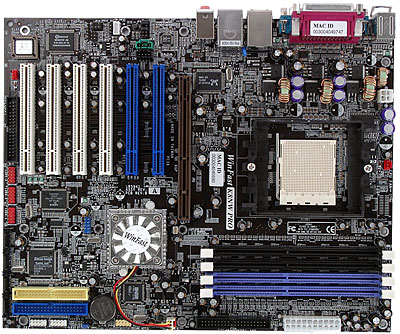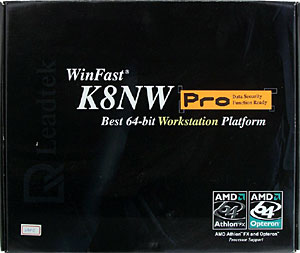Leadtek K8NW Pro (NVIDIA nForce3 Pro 150) Mainboard
|
The board has a rich suite of functions and accessories according to its position
on the performance workstations and top-end desktop market. The first
thing that attracted my attention was two blue PCI slots and AGP Pro slot.
While the latter doesn't raise questions, the color of the PCI slots made
me look through the documentation. This way Leadtek warns that you can't
install PCI Bus Master expansion cards into both these slots.

The layout is standard - it's not easy to reach connectors placed along
the left side, the audio-ins are placed in front of the PCI slots, and
it can be a problem to reach the memory modules with a video card installed.
Also, you can find it difficult to reach some jumpers when the board is
already installed. Their description is provided on the PCB. +5V Standby
is indicated with a green LED. The 3-phase switching voltage regulator
incorporates 2 capacitors of 2200 uF and 5 of 620 uF. There are also voltage
regulators of the AGP bus (2x1000 uF and several less capacious ones) and
of the memory (4x1000 uF).
No wasted space for components that didn't get included in the final
design. The board measures 305x245 mm (wide ATX, 10 fastening screws, all
edges fixed). System monitoring is supported by Winbond W83627HF-AW chip.
It controls:
-
processor, chipset, AGP bus, memory voltages, +3.3, +5V, VBAT and +5 V
Standby
-
rotation speed of 3 fans;
-
temperatures of the processor (built-in sensor) and the board (built-in
sensor).
There are 6 boards in all based on the same PCB! Our hero - K8NW Pro - is compatible
with the Opteron and Athlon 64 FX processors and equipped with a special
IDE port that supports data encryption. There is also a K8NW board without
the Pro function. Also, there are 2 K8N (Pro and non-Pro) and 2 K8NFX
(Pro and non-Pro) boards. The professional solutions differs from the
lower-level ones in the additional Secure IDE channel. The K8N has another
socket - Socket 754; it thus is deprived of one of the DIMM connectors
(three would be sufficient for the Athlon 64 single-channel controller)
and two PCI slots. This is already a desktop version.
The K8NFX is designed for the Athlon 64 FX only! Why to make a board
the distinguishing feature of which is that it doesn't support one of
two CPU types, compared to the other?... If you enter the page with the
K8NFX specs you will see that it's simply copied from the K8NW page!
Even the name is mistakenly copied! We think that when AMD announced
the Athlon 64 FX Leadtek had a strong design to offer a board for it,
but they got no board, so they decided to sell the old one under one
more name. Well, marketing is a tricky thing...
Ports & connectors onboard:
-
CPU socket (Socket 940);
-
4 slots for DDR SDRAM DIMM (paired, differ in color);
-
AGP Pro;
-
6 PCI slots (32bit, 33MHz);
-
Standard power supply connectors (ATX, 4pin for 12V);
-
FDD;
-
3 IDE slots (Parallel ATA) - on chipset, one supports X-Wall data protection
system;
-
4 Serial ATA slots - at the expense of an additional controller;
-
1 connector for a bracket with USB (2.0) ports;
-
3 connectors for a bracket with additional FireWire ports;
-
Connector for an X-Wall protection key bracket
-
Connector for audio-out from CD/DVD drive;
-
Connector for AUX-In;
- Connector for a standard IRDA module;
-
Connector for a CIR module;
-
Case Open sensor;
-
Connectors for a bracket with audio-outs and S/PDIF;
-
3 connectors for fans (2 with fan rotation control, one attached to the
chipset's fan).

Rear panel (left to right, units)
-
PS/2 mouse and keyboard;
-
LPT, 2 COM;
-
2 USB & RJ-45 (Ethernet);
-
2 USB & RJ-45 (Gigabit Ethernet);
-
3 audio ports (Mic-In, Line-In, Front).

Accessories
-
Package of the standard design with a handle;
-
Documentation: user manual in English;
-
ATA66/100/133 and FDD cabled in red cambric, 4 SerialATA cables;
-
Bracket with Center/Sub, Rear, S/PDIF-Out (TosLink and Coaxial);
-
Bracket with 2 FireWire ports;
-
X-Wall protection key;
-
I/O Shield;
-
CD with:
-
drivers;
-
user manual in Adobe Acrobat;
-
Adobe Acrobat Reader;
-
Leadtek SpeedGear;
-
DirectX 8.1.
Integrated controllers
-
audio controller based on the Avance Logic ALC658 AC'97 codec; 5.1 audio
system supported, front audio I/Os and S/PDIF connector provided;
-
2 network controllers, one based on the chipset and Realtek RTL8201BL PHY
controller with the support for 10Base-T/100Base-TX, the other on Realtek
RTL8110S-32, with the support for 10Base-T/100Base-TX/1000Base-TX;
- FireWire based on the Agere FW323-06, with 2 ports supported;
-
SATA RAID based on the Silicon Image SiI3114CT176, supports 4 SATA connectors
and RAID 0, 1, 1+0 and Spare;
-
X-Wall based on the eNova X-Wall LX-64 chip, data encryption on hard drive,
access is password protected without the protection key.
Settings
| jumpers and switches |
Jumper to clear the CMOS |
|
| SATA RAID on/off jumper |
|
| BIOS based on Phoenix-Award 6.00PG |
Setup of memory timings |
+ |
Row Cycle Time, Row Refresh Cycle Time, Row to Row Delay, Write
Recovery Time, Write to Read Delay, Read to Write Delay, Refresh Period, CAS Latency,
RAS to CAS Delay, RAS Precharge, Active to Precharge Delay |
| Setup of memory frequency |
+ |
Auto, 100, 133, 166, 200 MHz |
| Setup of AGP bus |
+ |
|
| Setup of PCI bus |
- |
|
| AGP/PCI frequency setup |
+ |
AGP(PCIx2)=Auto, 66-120 MHz |
| PCI IRQ manual assignment |
- |
|
| FSB frequency setup |
+ |
200-300 MHz in 1MHz steps |
| CPU clock ratio |
- |
|
| CPU voltage control |
+ |
Default, 0.8-1.7 V in 0.025V steps |
| DIMM voltage control |
+ |
Default, 2.5, 2.7, 2.8 V |
| NB voltage control |
+ |
Default, 1.7, 1.8, 1.9 V |
| AGP voltage control |
+ |
Default, 1.6, 1.7, 1.8 V |
We used the BIOS of 29.09.2003 as the latest available version.
Test results:
Write a comment below. No registration needed!
|
|
 |
|
|
|



